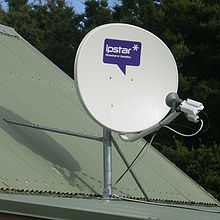Thaicom 4
 ipstar Satellite Dish |
 ipstar Satellite Terminal |
Thaicom 4, also known as IPSTAR, is a high throughput satellite built by Space Systems/Loral (SS/L) for Thaicom Public Company Limited and was the heaviest commercial satellite launched as of August 2005. It was launched on August 11, 2005 from the European Space Agency's spaceport in French Guiana on board the Ariane rocket. The satellite had a launch mass of 6486 kilograms. Thaicom 4 is from SS/L’s LS-1300 line of spacecraft.
The IPSTAR broadband satellite was designed for high-speed, 2-way broadband communication over an IP platform and is to play an important role in the broadband Internet/multimedia revolution and the convergence of information and communication technologies.
Overview
The satellite's 45 Gbit/s bandwidth capacity, in combination with its platform’s ability to provide an immediately available, high-capacity ground network with affordable bandwidth, allows for rapid deployment and flexible service locations within its footprint. The IPSTAR system is composed of a gateway earth station communicating over the IPSTAR satellite to provide broadband packet-switched communications to a large number of small terminals with network star configuration.
A wide-band data link from the gateway to the user terminal employs an Orthogonal Frequency Division Multiplexing (OFDM) with a Time Division Multiplex (TDM) overlay. These forward channels employ highly efficient transmission methods, including Turbo Product Code (TPC) and higher order modulation (L-codes) for increased system performance.
In the terminal-to-gateway direction (or return link), the narrow-band channels employ the same efficient transmission methods. These narrow-band channels operate in different multiple-access modes based on bandwidth-usage behavior, including ALOHA and TDMA for STAR return link waveform.
Spot Beam Technology
Traditional satellite technology utilizes a broad single beam to cover entire continents and regions. With the introduction of multiple narrowly focused spot beams and frequency reuse, IPSTAR is capable of maximizing the available frequency for transmissions. Increasing bandwidth by a factor of twenty compared to traditional Ku-band satellites translates into better efficiencies. Despite the higher costs associated with spot beam technology, the overall cost per circuit is considerably lower as compared to shaped beam technology.
Dynamic Power Allocation
IPSTAR's Dynamic Power Allocation optimizes the use of power among beams and allocates a power reserve of 20 percent to be allocated to beams that may be affected by rain fade, thus maintaining the link.
Coverage
IPSTAR has coverage over most of South East Asia including;
| Country | Gateway(s) | Service Provider(s) |
|---|---|---|
| Australia | Broken Hill, Kalgoorlie | ACTIV8ME, Westnet, SkyMesh, Clear Networks, BlueMaxx |
| Brunei | ||
| Cambodia | Phnom Penh | CAMSHIN, CAMNET |
| China / Hong Kong | Beijing, Guangzhou, Shanghai | China Telecom Satellite Communications Limited. |
| India | Mumbai, Delhi | Bharat Sanchar Nigam Limited (BSNL) |
| Indonesia | Jakarta | First Asia Network, INDONUSA |
| Japan | Tokyo | |
| Laos | Lao Telecom | |
| Malaysia | Kuala Lumpur | TIME, IPSAT, H-VISION |
| Myanmar | Yangon | MPT |
| New Zealand | Auckland | Farmside |
| Philippines | Manila | TNRI, Wit |
| Singapore | ||
| South Korea | Seoul | |
| Taiwan | Taipei | Chunghwa Telecom |
| Thailand | Bangkok | TOT, CS Loxinfo, CAT Telecom, SAMART Telcoms, ACUMEN, Hatari Wireless |
| Vietnam | Hanoi | Shin Satellite |
See also
External links
- IPSTAR website
- Biggest communication satellite launched
- Subscribe to IPSTAR Satellite Broadband
- IPSTAR Service Provider
- IPSTAR Tier 1 Reseller in Sabah and Sarawak
- IPSAT SDN. BHD.
- IPStar
| ||||||||||
| ||||||||||